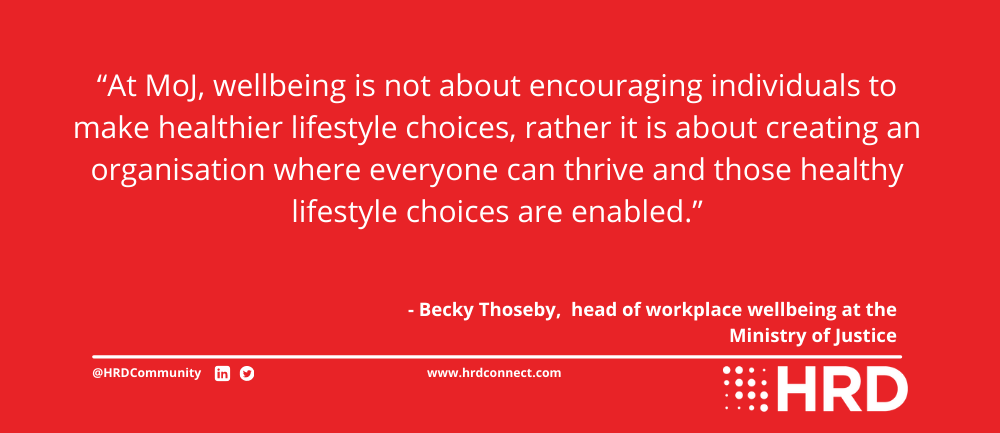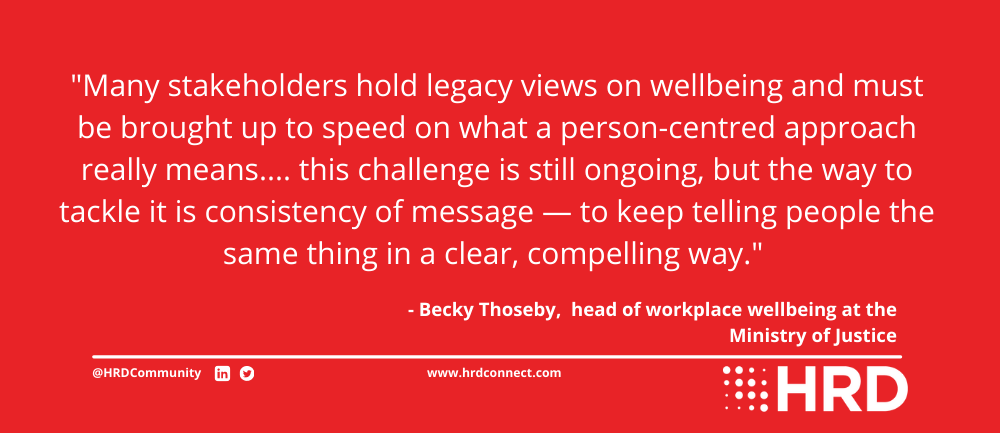-
Provided by

- Date published: Apr 11, 2022
- Categories
We know Covid has changed our world of work. That much is abundantly clear every time we log onto our company email server from our bedroom, join our colleagues for a Friday knees-up by Slack or step into the half-empty offices which were once buzzing fulcrums of our enterprise.
But there are other, less visible changes too, areas of challenge that remain unbridged. Like the record number of people requesting NHS sleeping aids (a topic we will cover in a separate article); the ongoing topic of burnout, which has affected over 40% of the UK workforce since the pandemic began; and the re-emergence of workplace bullying, driven by isolation and the cowardly convenience of digital technologies.
As HR leaders, it’s easy for us to be preoccupied by the Great Resignation and the ever-more competitive war for talent. But our first duty is one of care, to the people who work for us. And this demands a fundamental rethink.
To protect our employees in a world being reshaped by distance working (not to mention political turmoil and a soaring cost of living) it is crucial we adopt a people-first approach. Instead of building our strategies around issues – the immediate, pragmatic needs of our organisation – we need to build them around the people who work for us, and find ways to maximise protection as well as output.

This is a key priority for Becky Thoseby, head of workplace wellbeing at the Ministry of Justice (and a regular contributor to HRD Connect).
The task of pivoting MoJ’s approach to wellbeing is not easy. At the time of writing the department comprises 88,000 people across England and Wales and oversees 500 courts and tribunals, as well as 121 prisons. As the head of the UK’s criminal and civil justice systems, its day-to-day responsibilities cannot simply be suspended while the organisation pivots towards a new managerial paradigm.
However, Becky believes that this shift is essential. On one hand, she says it will benefit everyone MoJ serves — “on a basic level, people perform better when they’re in their best wellbeing state” — but it will also protect staff serving in challenging and sometimes vulnerable roles.
Above all, this change in mindset will enable MoJ to take a holistic approach to wellbeing, which has been shown to deliver increased engagement and productivity as well as employee satisfaction.
“[This people-centred mindset] enables the organisation to move forward from treating issues like mental health and musculoskeletal problems as single issues, when they are often not,” Becky says.
“For example, 67 percent of employees with financial problems report at least one other health problem, and one in five employees with a physical health condition will also have mental health issues.
“At MoJ, wellbeing is not about encouraging individuals to make healthier lifestyle choices, rather it is about creating an organisation where everyone can thrive and those healthy lifestyle choices are enabled.”

Priorities
The vision mapped out by Becky is at once universal and individual. On one hand, each employee is recognised as an individual, with their own package of needs; on the other, inclusion is the driver for MoJ’s entire wellbeing strategy, so everyone benefits and no-one is left behind.
These twin north stars guide a raft of specific principles:
- Individuals must take responsibility for their own wellbeing.
- However, line managers must support their team members based on a holistic picture of their needs.
- Senior leaders must create a culture of wellbeing through their behaviour.
- The organisation must create an inclusive environment where everyone can thrive.
To these last two points, Becky has invested in the creation of a network of ambassadors who can role-model desired behaviours. These ambassadors, known as Senior Wellbeing Champions, are led by a board-level champion. Each business area then has their own local champions in a structure that resembles a family tree.
This policy is very much aligned with established best practice. As Helen Gillett, chief operating officer of employee wellbeing platform BetterSpace, wrote in a recent blog post, “it’s very simple. If you talk about a wellbeing culture but the senior people don’t contribute, then it’s likely others won’t either.
“This means being intentional about certain things – ‘I don’t want to be contacted outside working hours (except in specific, defined and agreed circumstances) therefore I shouldn’t be contacting colleagues then either.’ It’s no good sending a bunch of evening and weekend emails and then saying ‘oh but I didn’t expect you to answer!’”
Becky echoes these sentiments. She says her ambassadors have been vital in securing buy-in to her new approach across MoJ’s multi-pronged organisation, and encouraging others to come forward about their wellbeing challenges.
However it’s not enough to seed a network of role models and expect them to adopt the right behaviours straight away. These new cultural change-makers need to be educated. Many stakeholders, Becky says, hold legacy views on wellbeing and must be brought up to speed on what a person-centred approach really means.
“This might be because they have personal investment in a particular issue, or they find the ‘fix the organisation’ approach daunting compared to an approach where we tell employees how to look after themselves and try to encourage them to make the right choices.
“For me, this challenge is still ongoing, but the way to tackle it is consistency of message — to keep telling people the same thing in a clear, compelling way. Also to get people in the business, ‘real people’ as I like to call them, delivering the message for you.
“When I hear someone talking about the person-centred approach without prompting, I know I’ve done something right.”

Top down, bottom up
With this in mind, Becky worked with L&D colleagues to develop a specific training course, entitled Wellbeing for Line Managers. During lockdown, Becky says this was the most popular course on the MoJ e-learning platform, over three times more popular than its nearest challenger.
In parallel with this top-down approach, Becky and her colleagues have sought to trigger bottom-up engagement by reaching out to staff directly.
A wellbeing roadshow has been established across MoJ, including the notoriously hard-to-reach Prison Service, to announce the new approach and communicate its priorities. However, the real heavy lifting is being done by surveys and questionnaires, which are providing a mine of data to drive the person-centred approach and set the agenda for the quarterly meetings of senior wellbeing champions.
“The cornerstone of our data-informed approach is our quarterly wellbeing pulse survey,” Becky reveals. “The first survey was run in April last year. I decided to start off by doing a quarterly pulse survey, which used a sample of employees.
“At that time, circumstances were changing so quickly and I wanted to be able to take the temperature of the organisation quarterly, so that we can respond quickly to fluctuations in factors that might affect wellbeing. If at that point I had done a census survey, it would have taken a few months to analyse the results, which would not have enabled me to respond in as agile a way as I might have needed to.
“In October we hold our annual census survey, the People Survey. This is organisation-wide, so there is a much bigger push to complete it, which means higher participation rates. The questions are also different to the ones I ask in my wellbeing survey, so while that means we can’t make a direct comparison, it does mean I get a bit of a different perspective.”

Anonymous reflection, reliable results
Again, this is very much on-trend. As a hive of respected HR commentators have pointed out, surveys are crucial in employee wellbeing. They give people a safe space to discuss their issues anonymously, and allow respondents to reflect on their answers (which may not be possible in a live, person-to-person setting).
The feedback, as a result, can be more reliable than even the best-trained AI tool. Facebook’s people leads say that when they ask their people how long they intend to stay with the company, the results are more than twice as accurate as industry-leading machine learning.
The results of Becky’s surveys have certainly provided food for thought. For one thing, the results of the April and July surveys showed no significant difference, even though life changed dramatically during that quarter.
Becky says this was “a big shock”, but adds: “It tells me that wellbeing, as we are choosing to measure it, is less dependent on whether people could go to the pub or visit their mum, but more about the reality of their day-to-day life in the workplace.
“Secondly, stakeholders needed a lot of reassurance about the methodology being used and particularly the sampling methodology. The main question was “how do you know the results are valid when you’re not asking everyone”. I must admit this was unexpected to me because I had just assumed there are a team of analysts who know what they’re doing… so that should be sufficient reassurance that the results are going to be valid.
“Clearly not, so, lesson learned. For the July survey I was much more explicit when engaging with stakeholders in preparation for the survey, exactly what methodology would be used.”
It’s about building knowledge
Going forward, this emphasis on reliable, first-hand data will be redoubled. The people team will continue to collect survey results, triangulating them with anecdotal evidence picked up from staff networks, HR business partners and external reports. The more data-points available, the better.
“I’m very clear that in the world of wellbeing, the evidence base to say what works and what doesn’t, simply doesn’t exist,” Becky says. “So it’s not about introducing things we know will work, it’s about building our knowledge base and testing things out.”
Indeed, Becky is clear that the data will be backed up by real-world anecdotal accounts, gleaned through everyday interaction with colleagues. This won’t just provide crucial information for the future; it will enable the people leads to raise awareness of their current work, particularly the challenge of upskilling managers and leaders.
“In an organisation this size, it’s simply impossible to communicate with everyone in one go. So I have to rely on others to get the message out for me, to be my mouthpiece.
“This has been a slow process, finding out who the right people are, building relationships with them, getting them to understand the message and then finally finding ways for them to deliver it.”

At the moment, however, all the information is trending in the right direction.
“This year, there seems to be a renewed appetite to engage with wellbeing”, Becky reports. “I don’t know whether senior colleagues are feeling refreshed after the Christmas break, or whether the results of the October People Survey have got their attention, but I’ve definitely been experiencing a new willingness to engage with wellbeing in the right way.
“One of my senior stakeholders recently expressed that he wanted to “go beyond gimmicks and do something that will make a real difference”. This is exactly what I want to hear, so I’m putting a lot of my energy into supporting him at the moment.”
Such support will be doubtless welcome. MoJ is in the middle of an extremely challenging period, grappling with a chronic Crown Court backlog and facing questions from MPs about unspent funds. Stress and burnout are simply part of the job.
It would be easy to scrap the wellbeing strategy and focus on day-to-day crisis management. However, with Becky at the helm, the MoJ will remain committed to its long-term future, and strive to do justice to its own employees as well as the millions it serves.
